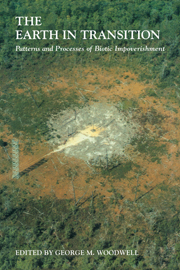Book contents
- Frontmatter
- Contents
- Preface
- Acknowledgments
- List of Contributors
- Part I Global Change and the Patterns of Impoverishment
- Part II Chronic Disturbance and Natural Ecosystems: Forests
- Part III Chronic Disturbance and Natural Ecosystems: Woodlands, Grasslands, and Tundra
- Part IV Chronic Disturbance and Natural Ecosystems: Aquatic and Emergent Ecosystems
- 18 Changes in a Red Sea Coral Community Structure: A Long-Term Case History Study
- 19 Are Deep-Sea Communities Resilient?
- 20 Species Dominance–Diversity Patterns in Oceanic Communities
- 21 Natural and Anthropogenically Imposed Limitations to Biotic Richness in Fresh Waters
- 22 Human Impacts on the South Florida Wetlands: The Everglades and Big Cypress Swamp
- 23 The Impoverishment of Aquatic Communities by Smelter Activities near Sudbury, Canada
- 24 Biotic Impoverishment: Effects of Anthropogenic Stress
- Part V Conclusion: Steps toward a World That Runs Itself
- Name Index
- Subject Index
18 - Changes in a Red Sea Coral Community Structure: A Long-Term Case History Study
Published online by Cambridge University Press: 24 November 2009
- Frontmatter
- Contents
- Preface
- Acknowledgments
- List of Contributors
- Part I Global Change and the Patterns of Impoverishment
- Part II Chronic Disturbance and Natural Ecosystems: Forests
- Part III Chronic Disturbance and Natural Ecosystems: Woodlands, Grasslands, and Tundra
- Part IV Chronic Disturbance and Natural Ecosystems: Aquatic and Emergent Ecosystems
- 18 Changes in a Red Sea Coral Community Structure: A Long-Term Case History Study
- 19 Are Deep-Sea Communities Resilient?
- 20 Species Dominance–Diversity Patterns in Oceanic Communities
- 21 Natural and Anthropogenically Imposed Limitations to Biotic Richness in Fresh Waters
- 22 Human Impacts on the South Florida Wetlands: The Everglades and Big Cypress Swamp
- 23 The Impoverishment of Aquatic Communities by Smelter Activities near Sudbury, Canada
- 24 Biotic Impoverishment: Effects of Anthropogenic Stress
- Part V Conclusion: Steps toward a World That Runs Itself
- Name Index
- Subject Index
Summary
Editor's Note: Occasionally a circumstance arises in nature that, treated imaginatively by a talented scholar, allows unusual insights into cause and effect. Yossi Loya, an Israeli ecologist, recognized such an opportunity in his studies of coral communities in the Gulf of Eilat and has used the chance to gather further insights into the patterns of diversity and dominance in natural communities under various types of stress. His observations not only reveal further details of the structure and function of these communities, but reconfirm the importance of long-continued studies of specific sites to determine changes under way in response to intensified human influence, details that would otherwise be lost as the biota moves inexorably through various stages of impoverishment in response to uncontrolled chronic disturbance.
Loya offers a case history study of a coral reef exposed in different places to oil pollution and climatic anomalies. While the circumstances seem specialized, they are increasingly common, and the observations Loya makes are emergent generalities, broadly applicable to natural communities under stress.
Introduction: The Reef at Eilat
One of the central questions of ecology deals with the mechanisms that generate and maintain the diversity of organisms. There have been many varied opinions and large numbers of publications on this subject. I review here briefly our studies of community structure of corals at Eilat, Red Sea, describe changes that have occurred in coral diversity due to human versus natural disturbances, and discuss mechanisms that promote and maintain high diversity of corals on the reef-flats of Eilat.
- Type
- Chapter
- Information
- The Earth in TransitionPatterns and Processes of Biotic Impoverishment, pp. 369 - 384Publisher: Cambridge University PressPrint publication year: 1991
- 6
- Cited by



